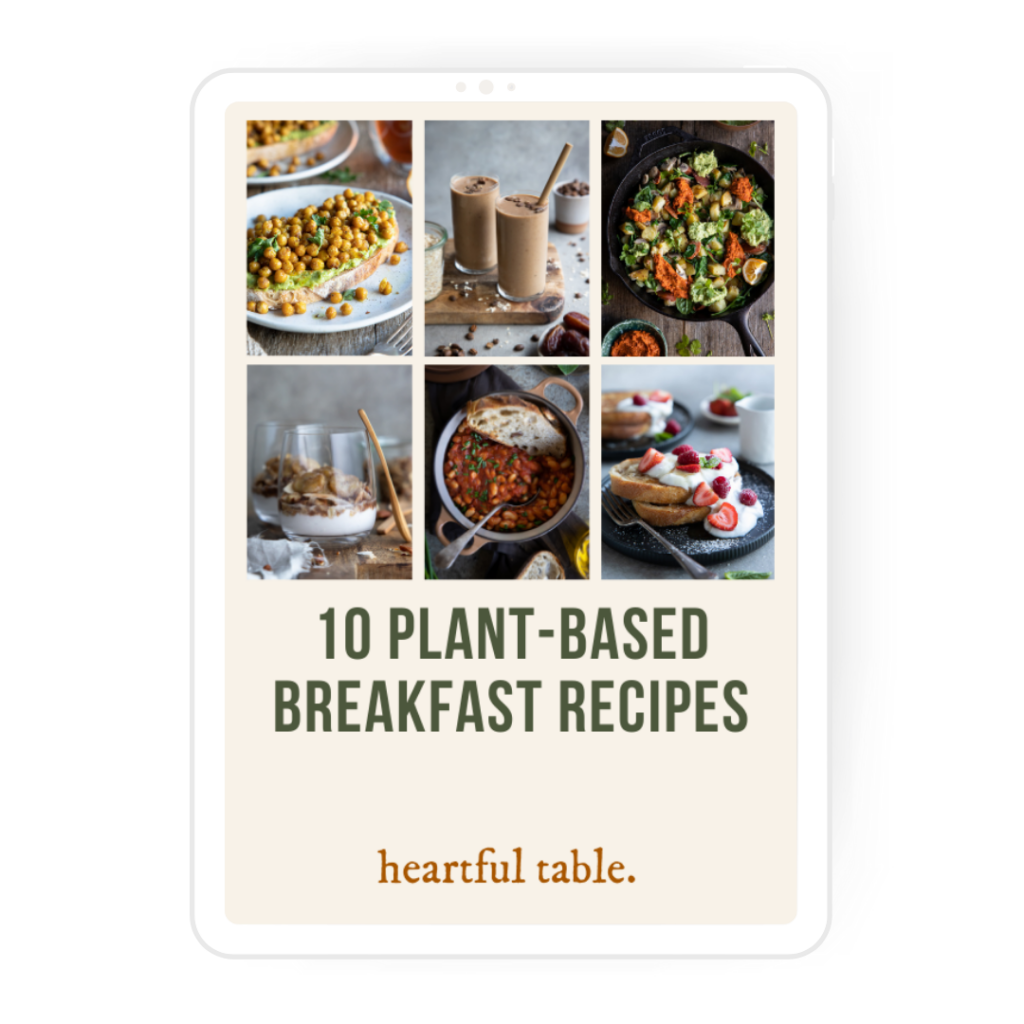Vegan Plum Dumplings (Posne Knedle sa Šljivama)
Plum dumplings are made of sweet ripe freestone plums wrapped in a soft potato dumpling dough covered in a cinnamon sugar breadcrumb. You’ll be pleasantly surprised how easy they are to make and even better, how affordable the ingredients are.
It’s a delicious way to use only a handful of ingredients that are pantry staples and to celebrate plums when they’re in season.
The dumplings are easy to freeze so you can enjoy them all year round.
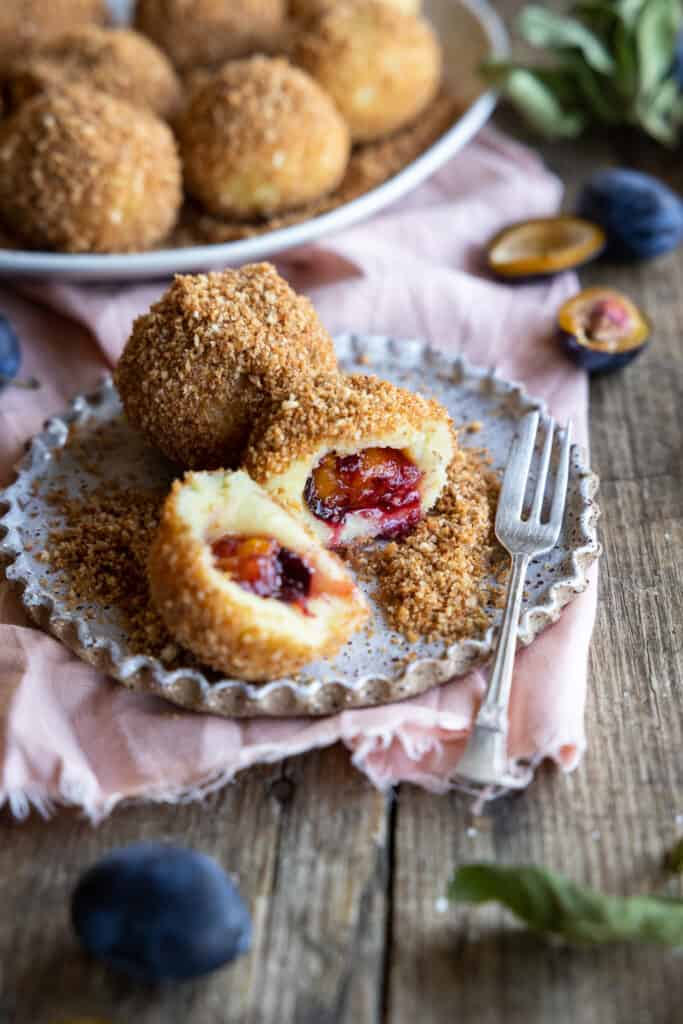
The origins of plum dumplings
If you’ve grown up with these types of dumplings in the house, get ready for some nostalgic feels! I know I’ve certainly had them since we created a vegan version of this recipe.
Posne knedle sa šljivama is what it translates to in Croatian and that’s where these specific plum dumplings have originated from.
Plum dumplings are a popular dessert across eastern and central Europe. They’re filling, not too sweet, and the perfect way to use stone fruit.
In Austria, you’ll find that apricots are used, and in Croatia, the Czech Republic, Romania, Poland, and Hungary, plums are the popular choice.
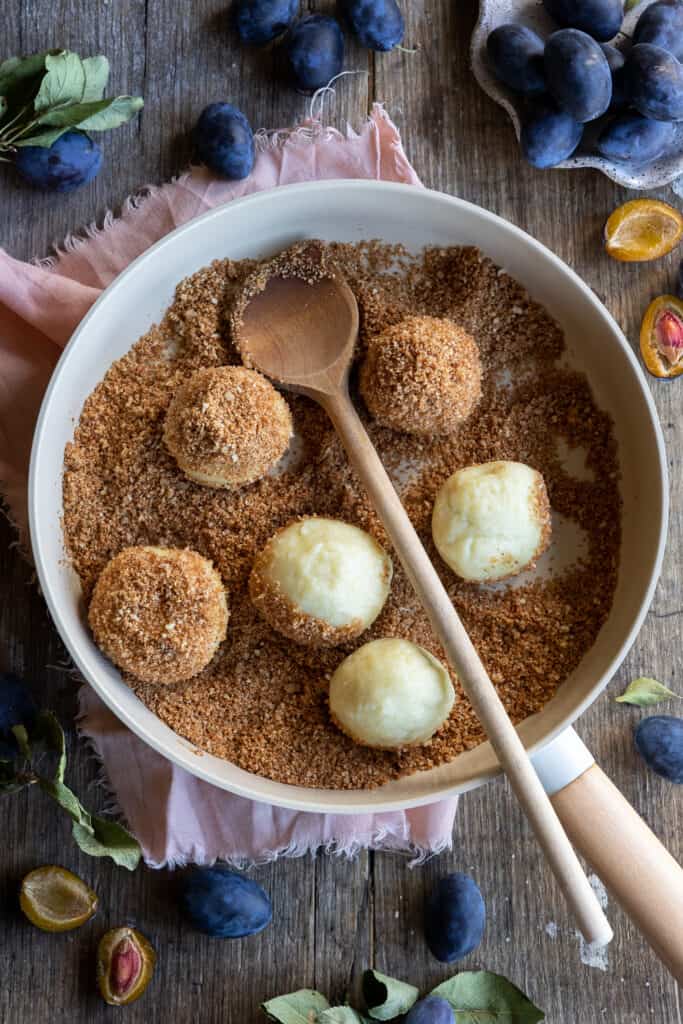
Are plum dumplings normally vegan?
The traditional recipes aren’t vegan as they use butter, eggs, cream cheese, and sometimes even lard, but trust me, these are just as good!
They’re also served slightly differently. Most are served with sweetened breadcrumbs, some with poppyseed, and some can be served with sour cream.
I’ve only ever had them with sweet breadcrumbs and it’s super easy to veganise.
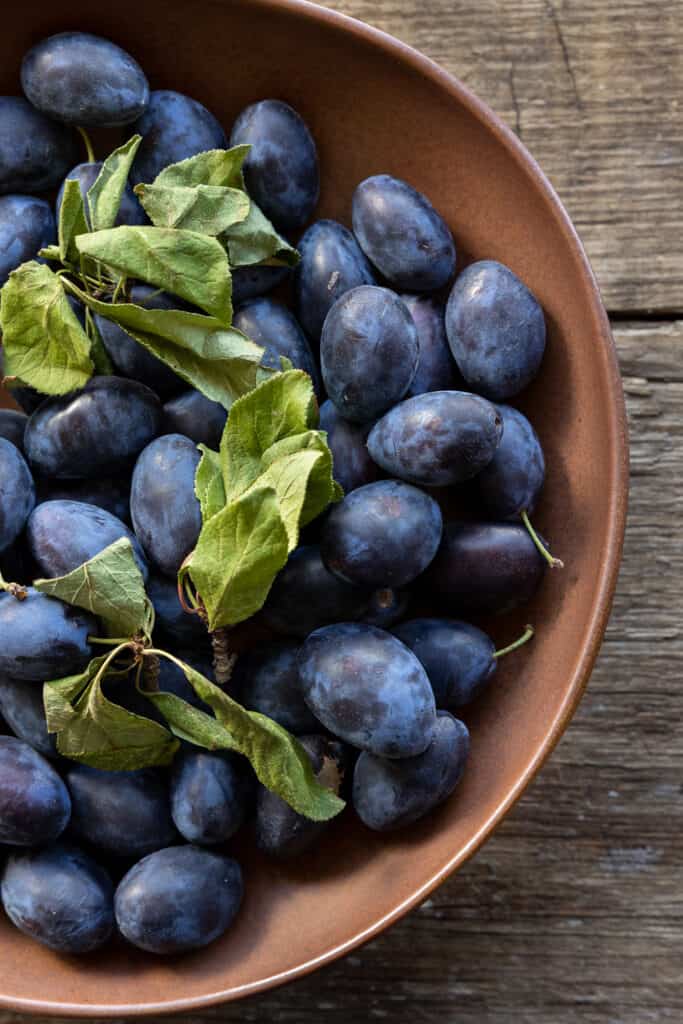
What are the best variety of plums to use for potato plum dumplings?
First of all, it’s important to use freestone plums for dumplings. What are freestone plums, you ask? They’re a variety of plums that once opened, the stone inside is not attached to the flesh of the plum- you can remove it without any issue.
This is ideal as you want to keep the whole plum intact and to replace the stone inside the plum with a small amount of sugar so that it can close up again before being wrapped in the potato dough. This will result in the perfect plum dumplings.
Here’s a list of freestone plums that are ideal for these dumplings:
- Seneca
- Damson
- Moyer
- Italian Prune
- Imperial Epineuse
- Stanley
Sometimes they’re just known as “European plums”. You want to use smaller plums that are ripe, so the end of the summer-early autumn (fall) season is the ideal time.
You’re looking for a red-purple colour rather than a blue-purple. You’ll see the difference between a super-ripe plum and a slightly underripe (still sweet) plum when they’re cut in half. You’ll find that these plums have a dusty white film on them.
See the image below for the two dumplings that have been cut in half. The one on the top right has turned into more of a jam-like consistency. Whereas the one further down is still in one piece and a bit firmer. This, of course, comes down to personal preference of how you like your dumplings.
The ideal size is the size of a large strawberry. They’re more of an oblong shape rather than a round shape.
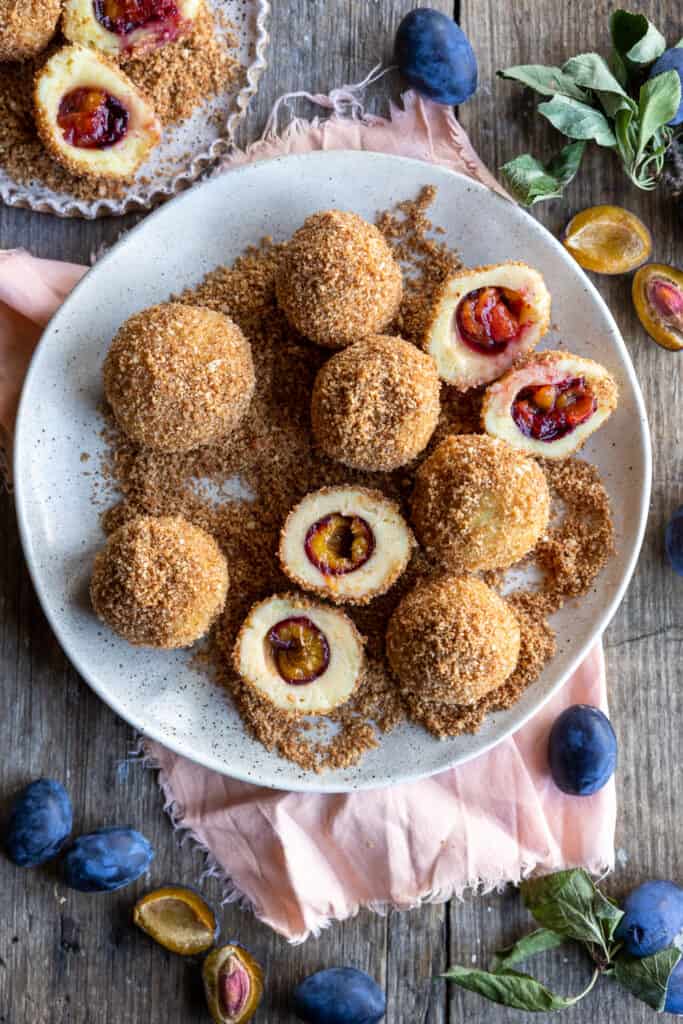
A few tips to get the perfect Croatian plum dumplings (aka posne knedle)
- When buying the potatoes, try to select potatoes of similar size. This makes it easier for all of them to cook through simultaneously.
- Do not peel the potatoes and cut them into small chunks. Although this may seem like a time saver — when boiling the potatoes this way the dough will be too wet to work with and you may need to add more flour.
- Do not use an electric appliance to mash the potatoes. Using one of these will make the mix smooth but very sticky and stretchy and this is not the desired outcome. Best results are achieved using the back of the fork, a potato ricer or masher. This way you can make sure there are no lumps but the mash is still fluffy and soft.
- Be careful not to add too much flour as the dumplings will be hard and chewy. Instead you’ll know that the dough is ready when it’s fluffy, elastic and doesn’t stick to your fingers.
- The amount of flour you’ll need will depend on how wet or dry your potatoes are. So feeling is very important with these. However, I’ve made them 3 times with this same recipe, and used different potatoes, and the quantities of flour to potato ratio was spot on.
- Depending on the size of the plums available to you, you may want to only put half a plum in each dumpling instead if they’re a little on the large side. Still make sure to add the sugar in the middle.
- These freeze very well. If you feel you won’t eat the whole lot, place the UNCOOKED dumplings on a tray lined with baking paper and place them into the freezer. When they have just frozen after a couple of hours, you can put them altogether into a freezer bag. To cook the frozen dumplings, take them out of the freezer and place them directly into a pot of boiling water. Then wait for them to rise to the top as you would instructed in the recipe below.
- It’s essential that the plums are juicy, sweet and in season. When they cook inside the dumpling they create the jam of the dish so it will not work if the plums are hard and flavourless. See the list above for the best plum varieties to use and ideal size.
- If you’d like to make this recipe when plums aren’t in season, you can use plum jam instead. Alternatively, if you can’t find the right plums, you can make them with apricots, or apricot jam. If using jam, skip the additional sugar as it will be sweet enough.
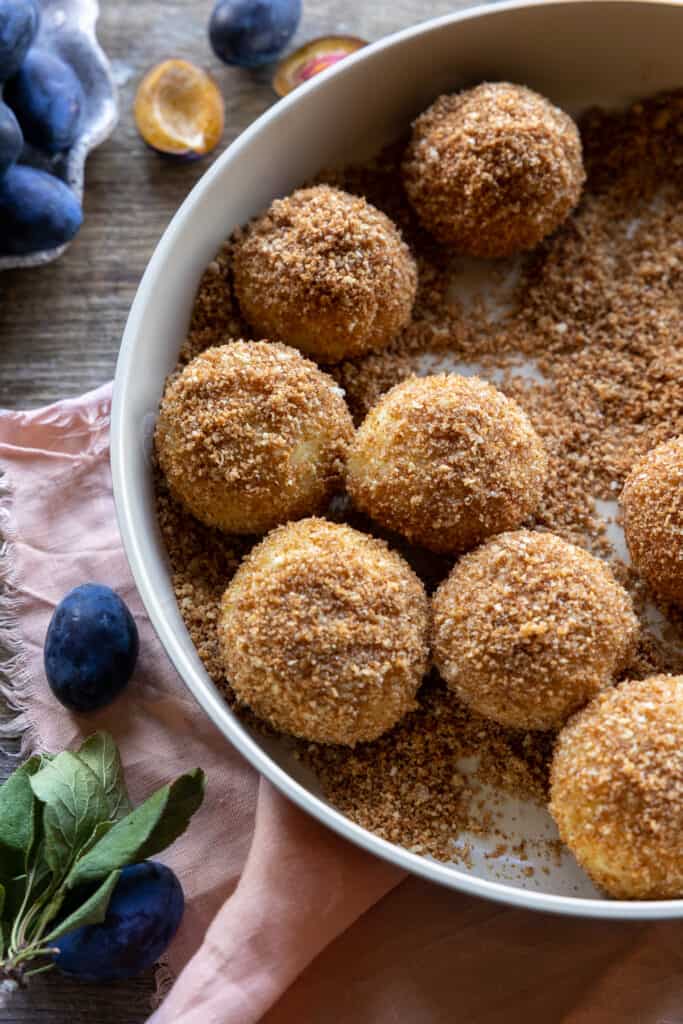
The perfect dough to plum ratio for these dumplings
The dumpling dough to plum ratio should be as pictured. It should be fairly even once cooked as the dough expands a little as it cooks. If there is more plum to dumpling ratio, the plums are too big and you’ll need to cut them up.
If you have too much dough to plum ratio the dish will be noticeably dough dominant and the sweetness and texture of the plum won’t come through as much.
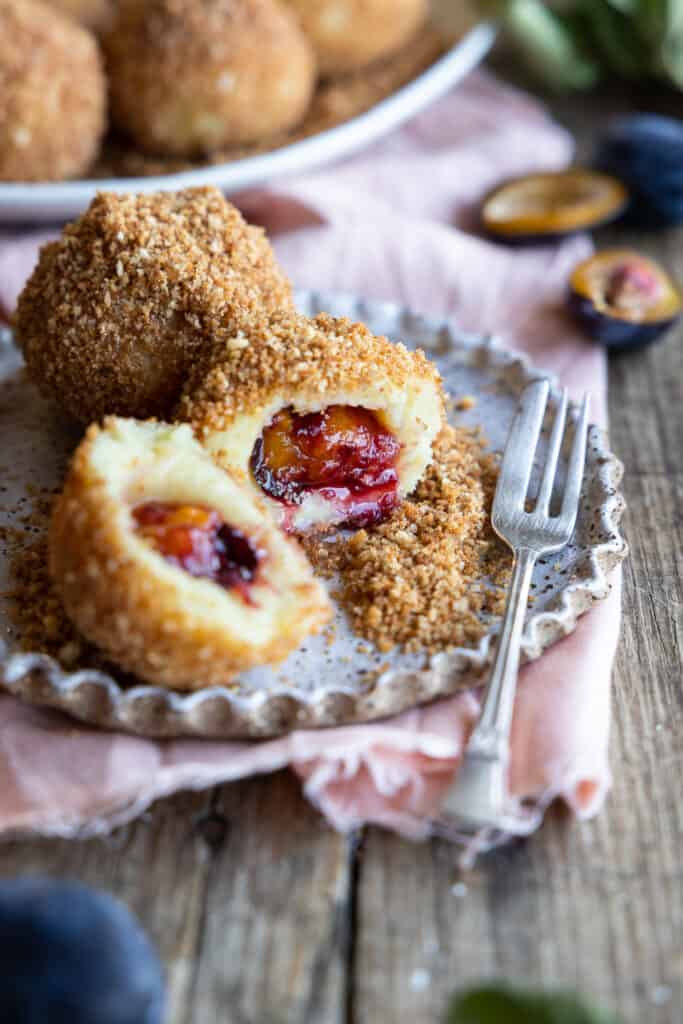
I hope you give these plum dumplings a try! Even if you’ve never had them before and have fond memories of enjoying them, I’m confident that you’ll love this recipe!
I need to reiterate again that they’re pretty filling. Some people even enjoy them as a main dish! I don’t know about you, but something sweet for lunch is just a little too odd for me. At least a light meal, followed by these beauties is the perfect way to enjoy them.
Other Balkan dessert recipes you’ll love:
- Vegan Kremšnita (Vanilla & Custard Cream Cake)
- 3-Ingredient Chestnut Puree With Whipped Coconut Cream (Kesten Pire)
- Easy Vegan Apple Burek (Posna Pita Sa Jabukama)
- Vegan Cherry Strudel with Cream Cheese
- Vegan Tufahije Recipe (Bosnian Walnut Stuffed Poached Apples)
- Sweet Poppy Seed Pasta
If you try this recipe, let me know! We’d love for you to leave a comment and rating below. If you want to go that extra mile, tag us on Instagram or share your photo of the recipe on Pinterest.
Print
Vegan Plum Dumplings (Posne Knedle sa Šljivama)
- Prep Time: 40 minutes
- Cook Time: 25 minutes
- Total Time: 1 hour 5 minutes
- Yield: 10 dumplings – 5 serves
Description
Plum dumplings are a classic European dessert made of sweet ripe freestone plums wrapped in a soft potato dumpling dough covered in a cinnamon sugar breadcrumb. They’re easy to make and a filling dessert to share with others.
Ingredients
Dumplings:
- 500g / 1.1 pounds starchy potatoes,* washed (do not peel them)
- 10 small plums,*
- ¼ teaspoon salt
- 1 tablespoon neutral oil (sunflower or rice bran are great)
- 1 cup/ 140g all-purpose flour
- 2½ teaspoons brown sugar
Breadcrumb topping:
- 2 tablespoons vegan butter (or coconut oil)
- 1 cup / 100g breadcrumbs
- ½ teaspoon cinnamon
- ⅛ teaspoon vanilla powder, or vanilla bean (optional)
- ¼ cup / 38g brown sugar
Instructions
- Place the potatoes in a large pot with just enough water to cover them and bring the water to a boil. Cook the potatoes until you can pierce one and it goes through without hesitation. It should take between 25-35 minutes.
- While the potatoes are cooking, wash the plums, cut them lengthways on one side and take out the pips. Set aside.
- When the potatoes are cooked, hold each one mid-air with a fork, peel back the skin with a pairing knife, and add them to a large bowl. Mash the potatoes with a potato ricer or masher. Please do this while potatoes are hot because this way, the potatoes will break down easier, and the dough will be smooth. When all the lumps are out, add the salt, oil, and flour and knead the dough inside the bowl. When the ingredients have combined completely, take it out of the bowl and do it on a floured board or surface. Do not overwork the dough; this should only take a few minutes.
- Place a large pot of water on the stove to come to a boil while you shape the dumplings.
- Divide the dough into ten equal pieces by cutting it in half and then dividing that into five pieces each.
- Take a piece of dough in your hand, make a smooth ball, flatten it into a disc, and place a plum in the middle. Inside each plum, add ¼ teaspoon of sugar where the pip used to be. Then fold the dough over the plum until you get a nice round ball of dough. Ensure to seal the ball properly so that there is no plum showing- I usually do this first by pinching it shut, then rolling it in my hands to smoothen it out.
- When the water has come to a boil, lower the heat to low/medium and gently place the dumplings one by one in the pot using a slotted spoon, so you don’t splash hot water. If they stick to the bottom of the pot, just gently shake the pot to release them or use the spoon to push them gently. The dumplings are cooked when they rise to the top. It takes anywhere between 10-15 minutes for this to happen.
- While the dumplings are cooking, prepare the breadcrumb topping. In a large skillet or pan, add the breadcrumbs, butter, cinnamon, and vanilla on medium heat. Toast them constantly stirring, so they don’t burn. When they are nice and golden brown, turn off the heat and add the sugar. They can turn very quickly, so keep an eye on them.
- Once the dumplings have come to the top, pick them out of the water with a slotted spoon and roll them into the breadcrumbs immediately. This is the best way for the breadcrumbs to stick nicely when the dumplings are still damp and hot. Roll them around until they’re completely covered. You will have to do two rounds of boiling the dumplings, so you don’t overcrowd the pot.
- Serve on a plate with an extra sprinkle of breadcrumbs.
Notes
Potato variety and size: We’ve tried with King Edward and Dutch Cream, and they both worked great. Other varieties are Russet, Idaho or Yukon. When buying the potatoes, try to select potatoes of similar size. This makes it easier for all of them to cook through simultaneously.
Mashing potatoes: Do not use an electric appliance to mash the potatoes. Using one of these will make the mix smooth but very sticky and stretchy, which is not the desired outcome. Best results are achieved using the back of a fork, a potato ricer or masher. This way, you can make sure there are no lumps, but the mash is still fluffy and soft.
Plum varieties: Use small freestone plums. No larger than a large strawberry (ideally). The plums must be juicy, sweet and in season. When they cook inside the dumpling, they create the jam of the dish, so it will not work if the plums are hard and flavourless. I’ve listed a range of plum varieties that are ideal for this recipe earlier in the post.
Don’t have access to fresh plums? Try using plum jam instead. You’ll need 10 teaspoons of it- 1 teaspoon for each dumpling. You can then skip the brown sugar in the dumpling section, as it will be sweet enough. We also tend to freeze some plums when they’re in season to use them throughout the year if you don’t want to make an excess amount of dumplings. Alternatively, you can use apricots or apricot jam for a more Austrian-style dumpling. Again, small apricots that are ripe and sweet are ideal.
Freezing: These freeze very well. If you feel you won’t eat the whole lot, place the UNCOOKED dumplings on a tray lined with baking paper and place them into the freezer. When they have just frozen after a couple of hours, you can put them all together into a freezer bag. To cook the frozen dumplings, take them out of the freezer and place them directly into a pot of boiling water. Then wait for them to rise to the top as you would instructed in the recipe above.
See tips earlier in the post for more guidelines to make the best dumplings.
- Diet: Vegan

